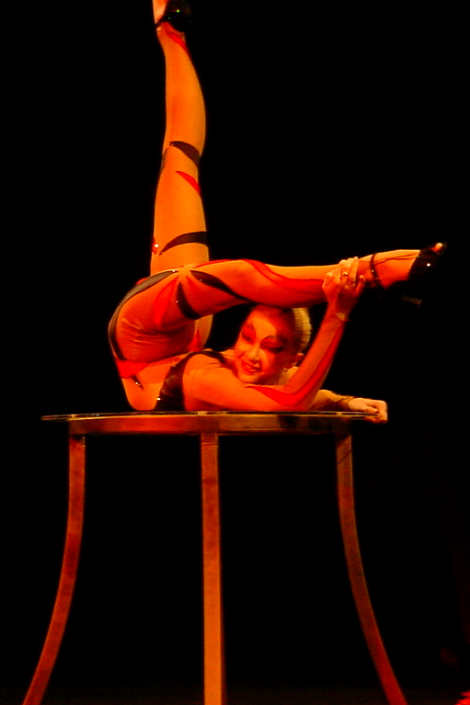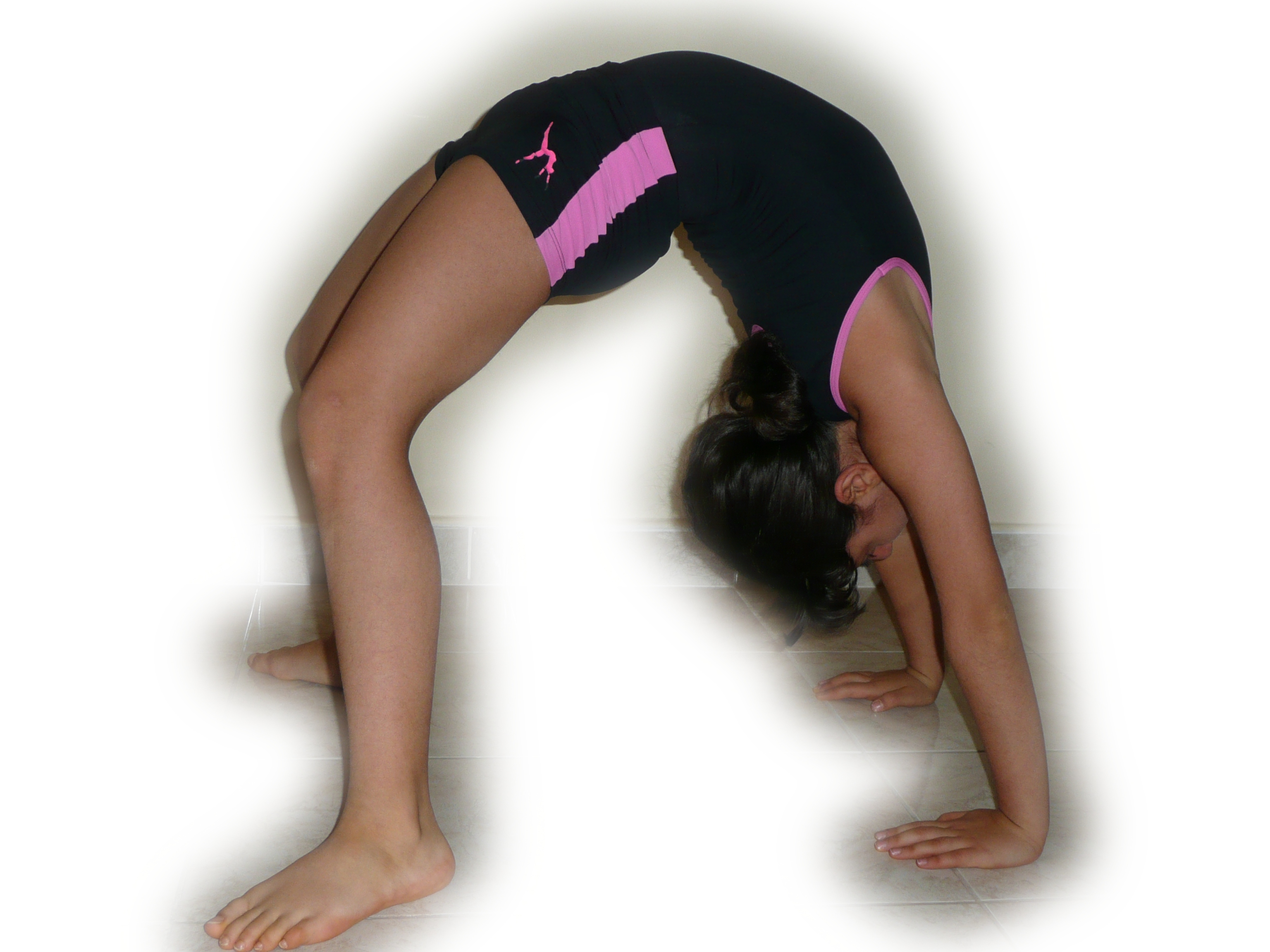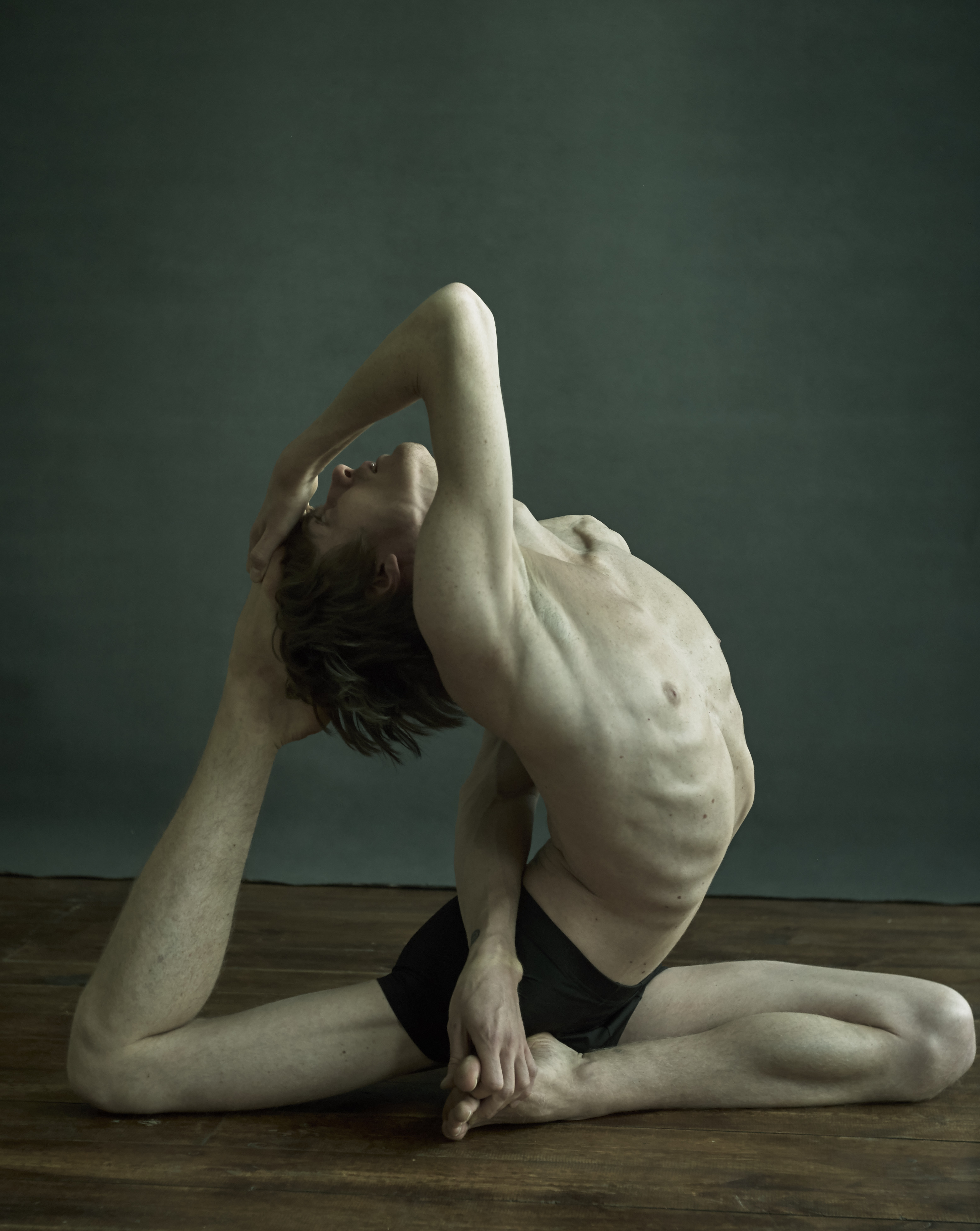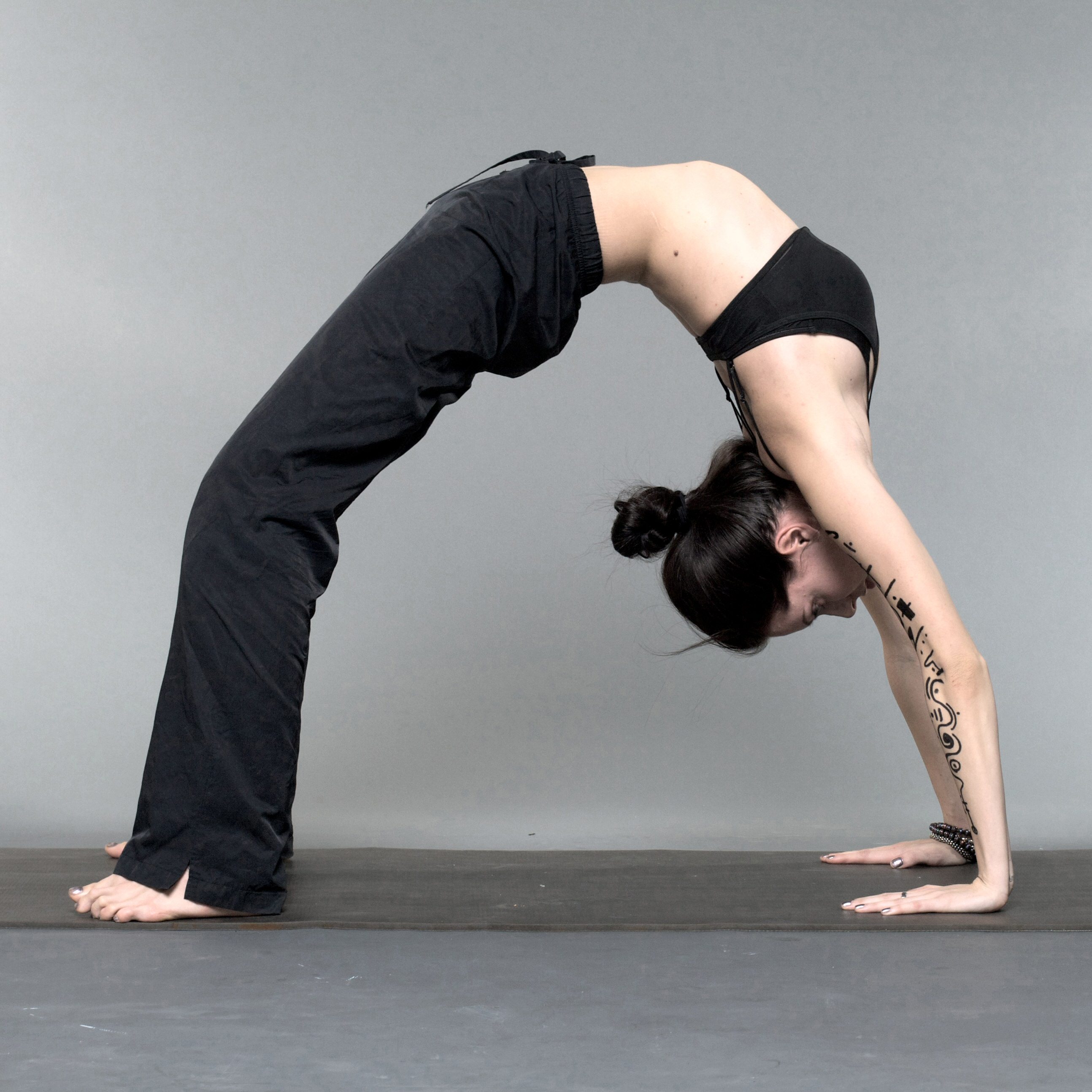|
Backbend
A backbend is a gymnastics, contortion, dance and ice skating move, where the spine is bent backwards, and catching oneself with the hands. Throughout the move, the abdominal muscles, obliques, and legs are used to steady the performer while curving backwards. Modern yoga includes some backbending asanas. Backbending can be acquired from intense training or genetics. Overview The spine consists of 24 vertebrae and between the vertebrae are small cushions referred to as disks. The movement of the vertebrae and the compression ability of the disks give the spine its flexibility. It is easier to perform a backbend after mastering a bridge. A bridge helps familiarize the bones and muscles to the positions and movements of a backbend. There are over a dozen yoga positions that are variant of the backbend. A "rib thrust" is common and deleterious to a good yoga pose, and one of the more common of several errors associated with the backbend. Uses The backbend is important in ... [...More Info...] [...Related Items...] OR: [Wikipedia] [Google] [Baidu] |
Asana
An asana is a body posture, originally and still a general term for a sitting meditation pose,Verse 46, chapter II, "Patanjali Yoga sutras" by Swami Prabhavananda, published by the Sri Ramakrishna Math p. 111 and later extended in hatha yoga and modern yoga as exercise, to any type of position, adding reclining, standing, inverted, twisting, and balancing poses. The '' Yoga Sutras of Patanjali'' define "asana" as " position thatis steady and comfortable". Patanjali mentions the ability to sit for extended periods as one of the eight limbs of his system. Patanjali ''Yoga sutras'', Book II:29, 46 Asanas are also called yoga poses or yoga postures in English. The 10th or 11th century '' Goraksha Sataka'' and the 15th century ''Hatha Yoga Pradipika'' identify 84 asanas; the 17th century ''Hatha Ratnavali'' provides a different list of 84 asanas, describing some of them. In the 20th century, Indian nationalism favoured physical culture in response to colonialism. In that envir ... [...More Info...] [...Related Items...] OR: [Wikipedia] [Google] [Baidu] |
Kapotasana
Kapotasana ( sa, कपोतासन; IAST: ''Kapotāsana'') or Pigeon Pose is a kneeling back-bending asana in modern yoga as exercise. Asanas based on One-legged King Pigeon pose, Rajakapotasana, are also sometimes called "Pigeon". Etymology and origins The name comes from the Sanskrit words ''kapota'' (कपोत) meaning "pigeon" and ''asana'' (आसन) meaning "posture" or "seat". A different (standing) pose is given the name Kapotasana in the 19th century ''Sritattvanidhi''. The modern pose is described in the 20th century in ''Light on Yoga''. Asanas based on King Pigeon pose or Rajakapotasana are sometimes called Pigeon; for example, ''Yoga Journal'' describes a reclining (prone) variation of Eka Pada Rajakapotasana, One-Legged King Pigeon pose, as Pigeon. File:Sritattvanidhi pose called Kapotasana.jpg, The standing pose named "Kapotasana" in the 19th century ''Sritattvanidhi'' File:Raja-Kapotasana Yoga-Asana Nina-Mel.jpg, Rajakapotasana, King Pigeon pose, is ... [...More Info...] [...Related Items...] OR: [Wikipedia] [Google] [Baidu] |
Contortion
Contortion (sometimes contortionism) is a performance art in which performers called contortionists showcase their skills of extreme physical flexibility. Contortion acts often accompany acrobatics, circus acts, street performers and other live performing arts. Contortion acts are typically performed in front of a live audience. An act will showcase one or more artists performing a choreographed set of moves or poses, often to music, which require extreme flexibility. The physical flexibility required to perform such acts greatly exceeds that of the general population. It is the dramatic feats of seemingly inhuman flexibility that captivate audiences. Skills Many factors affect the flexibility of performers including age, genetics, stature, and adherence to rigorous physical training routines. Most contortionists are generally categorized as "frontbenders" or "backbenders", depending on the direction in which their spine is most flexible. Relatively few performers are equall ... [...More Info...] [...Related Items...] OR: [Wikipedia] [Google] [Baidu] |
Bridge (exercise)
The bridge (also called gymnastic bridge) is an exercise. Many variations of this exercise are employed throughout the world, most commonly the balancing of the body on the hands and the feet. It is intended to improve lower back and gluteus strength. Examples of bridging in sportive or self-defense applications are seen in Kung Fu, Judo, Brazilian jiu jitsu, Capoeira, mixed martial arts, and wrestling. In yoga, this particular pose is called Chakrasana, Urdhva Dhanurasana, or Wheel, while the Westernized nickname "Bridge pose" refers to a less rigorous supine backbend called Setu Bandha Sarvangasana, in which the body is fairly straight from knees to shoulders, and most of the bend is in the knees. Variations The bridging exercise is not a singular movement, but includes a wide range of variations and progressions. There is no single agreed upon "standard" variation of the bridge like with other common bodyweight exercises. Bridge hold The bridge hold is a static variat ... [...More Info...] [...Related Items...] OR: [Wikipedia] [Google] [Baidu] |
Rajakapotasana
Eka Pada Rajakapotasana ( sa, एक पाद राजकपोतासन; IAST: ''Eka Pāda Rājakapotāsana''), Rajakapotasana, or ne-leggedKing Pigeon Pose is a seated back-bending asana in modern yoga as exercise. The Yin Yoga form of the asana is named Swan Pose, while the Aerial yoga variant, supported in a hammock, is called Flying Pigeon Pose. The basic pose is described in the 20th century by two of Krishnamacharya's pupils, Pattabhi Jois and B. K. S. Iyengar; several other variants have been created. It is one of the yoga poses often used in advertising to convey desired qualities such as flexibility and grace. Etymology and origins The name comes from the Sanskrit words "eka" (एक) meaning "one"; "pada" (पाद) meaning "foot", "rāja" (राज) meaning "king", ''kapota'' (कपोत) meaning "pigeon" and ''āsana'' (आसन) meaning "posture" or "seat". The pose is described in the 20th century by two of Krishnamacharya's pupils, Pattabhi Jois i ... [...More Info...] [...Related Items...] OR: [Wikipedia] [Google] [Baidu] |
Urdhva Dhanurasana
Chakrasana ( sa, चक्रासन, lit=Wheel Pose, translit=Cakrāsana) or Urdhva Dhanurasana ( sa, ऊर्ध्वधनुरासन, lit=Upward-Facing Bow Pose, translit=Ūrdhvadhanurāsana) is a backbending asana in yoga as exercise. The one-legged variant is often chosen by yoga practitioners who wish to advertise themselves. Etymology and origins The name Chakrasana comes from the Sanskrit words चक्र ''chakra'', "wheel", and आसन ''āsana'', "posture" or "seat". The name Urdhva Dhanurasana comes from the Sanskrit ''urdhva'' ऊर्ध्व, upwards, and ''dhanura'' धनु, a bow (for shooting arrows). The pose is illustrated in the 19th century ''Sritattvanidhi'' as ''Paryaṇkāsana'', Couch Pose. Description In the general form of the asana, the practitioner has hands and feet on the floor, and the abdomen arches up toward the sky. It may be entered from a supine position or through a less rigorous supine backbend, such as Setu Bandha Sarva ... [...More Info...] [...Related Items...] OR: [Wikipedia] [Google] [Baidu] |
Ustrasana
Ustrasana ( sa, उष्ट्रासन; IAST: ''Uṣṭrāsana''), Ushtrasana, or Camel Pose is a kneeling back-bending asana in modern yoga as exercise. Etymology and origins The name comes from the Sanskrit words उष्ट्र Uṣṭra, "camel", and आसन, Asana meaning "posture" or "seat". A different (standing) pose is given the name Ushtrasana in the 19th century ''Sritattvanidhi''. The modern pose is described in the 20th century by two of Krishnamacharya's pupils, Pattabhi Jois in his Ashtanga Vinyasa Yoga, and B. K. S. Iyengar in his '' Light on Yoga''. Description Ustrasana is a deep backward bend from a kneeling position; the completed pose has the hands on the heels. The backs of the feet may be flat on the floor, or the toes may be tucked under for a slightly less strong backbend. The pose is one of the 26 asanas in the Bikram Yoga sequence. Variations The name Ardha Ustrasana, Half Camel pose, is given to two different poses. One is an eas ... [...More Info...] [...Related Items...] OR: [Wikipedia] [Google] [Baidu] |
Frick And Frack
Frick and Frack were a comedic ice skating duo of Swiss people, Swiss skaters who went to the United States in 1937 and joined the original Ice Follies show. "Frick" was Werner Groebli (April 21, 1915 – April 14, 2008), born in Basel. "Frack" was Hans Rudolf "Hansruedi" Mauch (May 2, 1919 – June 4, 1979), also born in Basel. Frick and Frack were known for skating in Alpine ''Lederhosen'' and performing eccentric tricks on ice, including the "cantilever spread-eagle", created by Groebli; and Mauch's "rubber legs", twisting and bending his legs while skating in a spread eagle position. Only a few skaters have successfully performed the duo's routines since. Michael Mauch, the son of Hans, described the origin of their names: "Frick took his name from a small village in Switzerland; Frack is a Swiss German, Swiss-German word for a frock coat, which my father used to wear in the early days of their skating act. They put the words together as a typical Swiss joke." History Frick an ... [...More Info...] [...Related Items...] OR: [Wikipedia] [Google] [Baidu] |
Low Back Pain
Low back pain (LBP) or lumbago is a common disorder involving the muscles, nerves, and bones of the back, in between the lower edge of the ribs and the lower fold of the buttocks. Pain can vary from a dull constant ache to a sudden sharp feeling. Low back pain may be classified by duration as acute (pain lasting less than 6 weeks), sub-chronic (6 to 12 weeks), or chronic (more than 12 weeks). The condition may be further classified by the underlying cause as either mechanical, non-mechanical, or referred pain. The symptoms of low back pain usually improve within a few weeks from the time they start, with 40–90% of people recovered by six weeks. In most episodes of low back pain, a specific underlying cause is not identified or even looked for, with the pain believed to be due to mechanical problems such as muscle or joint strain. If the pain does not go away with conservative treatment or if it is accompanied by "red flags" such as unexplained weight loss, fever, or signi ... [...More Info...] [...Related Items...] OR: [Wikipedia] [Google] [Baidu] |
Paralysis
Paralysis (also known as plegia) is a loss of motor function in one or more muscles. Paralysis can also be accompanied by a loss of feeling (sensory loss) in the affected area if there is sensory damage. In the United States, roughly 1 in 50 people have been diagnosed with some form of permanent or transient paralysis. The word "paralysis" derives from the Greek παράλυσις, meaning "disabling of the nerves" from παρά (''para'') meaning "beside, by" and λύσις (''lysis'') meaning "making loose". A paralysis accompanied by involuntary tremors is usually called "palsy". Causes Paralysis is most often caused by damage in the nervous system, especially the spinal cord. Other major causes are stroke, trauma with nerve injury, poliomyelitis, cerebral palsy, peripheral neuropathy, Parkinson's disease, ALS, botulism, spina bifida, multiple sclerosis, and Guillain–Barré syndrome. Temporary paralysis occurs during REM sleep, and dysregulation of this system can ... [...More Info...] [...Related Items...] OR: [Wikipedia] [Google] [Baidu] |









